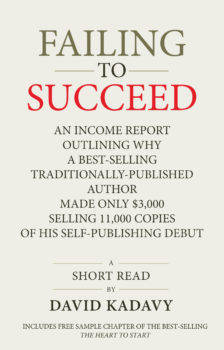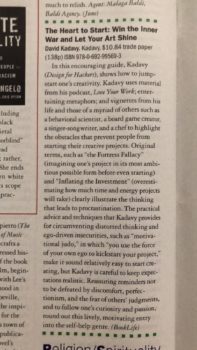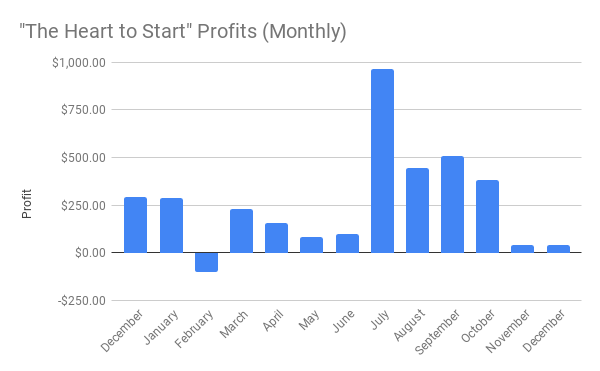Subscribe to blog updates via email »
Failing to Succeed: Why I Made Only $3,000 Selling 11,000 Copies of my First Self-Published Book
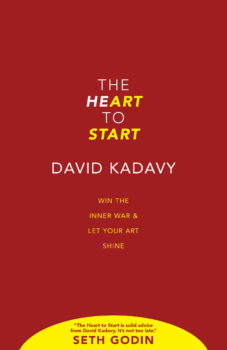 About a year ago, I launched my first self-published book, The Heart to Start. Looking at the numbers, it’s clear self publishing is not for everyone. In many ways, this first year looks like a failure. But it’s part of a larger plan toward success.
About a year ago, I launched my first self-published book, The Heart to Start. Looking at the numbers, it’s clear self publishing is not for everyone. In many ways, this first year looks like a failure. But it’s part of a larger plan toward success.
The reception of the book has exceeded my expectations. Yet financially, the book has fallen well short of my expectations.
What follows is a ~5,000-word abridged version of a much longer report. If you’d like the entire 8,300+ word breakdown, absolutely free and ready for your favorite e-reader, click here. (The ebook also includes a free sample chapter of The Heart to Start.)
The reception of The Heart to Start is better than any author could hope for in their first self-published book. After one year:
- The Heart to Start has more than 180 reviews on Amazon.com, with an average of 4.8 stars. I’m still blown away at how positive, heartfelt, and specific the reviews are. (Even the single one-star review is apparently a misguided positive review.)
- Publisher’s Weekly also reviewed the book positively, which put the paperback edition on the radar of libraries and brick-and-mortar retailers.
- It garnered positive blurbs from other accomplished authors in my genre: James Altucher, Jeff Goins, Todd Henry, and Bernadette Jiwa.
- The highlight of the past year was when The Heart to Start was recommended by Seth Godin himself on his blog.
Yet the financial results of The Heart to Start are enough to make even the most dedicated aspiring self publisher think twice.
After selling more than 11,000 copies in its first year, The Heart to Start has earned a little more than $3,000 profit. That’s a barely twenty-nine cents per book.
By comparison, I’ve sold about 16,000 copies of my traditionally-published book, Design for Hackers. That has earned nearly $50,000 in royalties (plus at least twice that in related course sales).
Those royalties are almost pure profit. Aside from overhead in my business like web hosting and my email marketing platform, I’ve spent almost nothing to sell my traditionally-published book. The expenses have been almost all on my publisher.
The myth of self-publishing earnings
These numbers don’t fit with the narrative you normally hear about self publishing. The typical traditional publishing deal pays about a fifteen-percent royalty. Yet when you publish directly to Amazon you can earn as high as a seventy-percent royalty. Even more damning to traditional publishing: that fifteen-percent royalty might be on the wholesale price of the book – not the retail price.
When you self publish, you keep more of the money, so when you self publish, you make more money – right?
Apparently not. In this piece, I’ll break down how I could sell so many books while making so little money. I’ll also tell you why this poor financial performance is not a failure in the context of my larger plan, and why I still think the future of The Heart to Start is bright.
Here’s the basic breakdown of my earnings and expenses for the first year of The Heart to Start:
- Copies sold: 11,374 (3,099 were free)
- Total Royalties: $19,173.31
- Fixed Production Costs: $431
- Advertising: $15,422.60
- Total Profit: $3,319.74
Selling more than 11,000 copies in the first year is great (okay, 8,000 if you don’t count the 3,000 I gave away). Making $19,000 in royalties is pretty solid, too – traditionally-published authors are lucky to earn that on their advances.
The big surprise is that I spent more than $15,000 on advertising. Why would a book with such a great reception from reviewers and readers even need to advertise? We’ll get to that later.
Why I self published (after traditionally publishing)
In April of 2017, I had the privilege of interviewing marketing and publishing legend Seth Godin on my podcast, Love Your Work. After spending a year and a half writing book proposals and pitching agents, I was heartbroken and frustrated. I was switching genres, so I couldn’t rely on my first publisher to offer me a deal, and I was beginning to realize how lucky I was to have that first book deal fall in my lap.
But when I shared my struggle with Seth, he said something that flipped a switch in me:
If you’re publishing yourself, you have the most committed publisher in the world…. You’re still going to be the head of marketing for your book. So how do you learn that? Well, you learn it by doing. And the easiest way to do it…is to come out with a book a week on the Kindle…. It costs nothing to do this. It costs less than it cost me to mail my proposals to book publishers. So what are you waiting for!?
—Seth Godin
I would learn far more by actually publishing books. The only thing standing in my way of doing that was my own ego – my own fear of failure, my own selfish need to follow up one success with an even bigger one.
So, I let go of all of my preconceived notions about what it meant to be successful as an author. I would forget about trying to get a big publishing deal. I would forget about trying to hit the New York Times best-seller list.
For now, I would start where I was. For now, I would self publish.
But as I looked into self-publishing options, I felt overwhelmed. It seemed like a minefield. I was afraid of making a wrong move – the type of wrong move that would make the whole project blow up in my face and end my fledgling career as an author.
It had now been almost six years since I had published my first book. I called myself an author – was I delusional? I had to prove to myself that I wasn’t. Authors publish books. It was time to publish a book.
“Launching:” The tiered approach makes self publishing easy
I knew from launching one book that doing a highly-coordinated launch takes a lot out of you. Dreading that experience was one reason it had been six years since launching my previous book. So, I took a “tiered” approach. I isolated each piece of the project so I could learn one piece at a time.
Here’s the timeline upon which I wrote and released The Heart to Start.
Email Course: April 2017: I already knew how to build a landing page and do email marketing, so I put up a landing page with an outline of the book. I promised my free subscribers to send a roughly-500-word chapter every day.
Incubation: June–October 2017: I took a break from working on the book, and made the “email course” available for purchase. I made another $1,071 here through purchases and donations. I haven’t counted this in my total royalties, because it appears this first draft may result in not one book, but three different books.
Second Draft: October 24, 2017: I completed the second draft, made it available on a Google Doc for free, and sent it to my email list.
Kindle: December 3, 2017: I launched with the Kindle version only. I agreed to Amazon ebook exclusivity for 90 days, to make the book eligible for Kindle Unlimited.
Paperback: December 19, 2017: I launched the paperback version on Amazon, through Createspace (it’s now sold through KDP Print).
Audiobook: January 24, 2018: I debuted the audiobook through ACX – which publishes to Audible and Apple iTunes.
Wide: March 28, 2018: After my initial 90-day Kindle Unlimited agreement ended, I launched on non-Amazon outlets (in the industry we call this going “wide”). I made a paperback version available globally through IngramSpark (I now realize KU didn’t preclude me from doing this sooner). I published the ebook directly to Google Play and Apple Books, then used Draft2Digital to distribute to Kobo, B&N, and others.
There was so much to learn each step of the way, I feel like I’ve earned another bachelor’s degree. I made a lot of mistakes and wasted a lot of time, but I’ve learned enough that I’ve been able to pull off more coordinated launches for later, shorter books. (After waiting six years to publish my second book, this second book started a wave of publishing three books in six months.)
Relative to doing a “perfect,” coordinated launch, a tiered approach makes launching a book easy.
Fixed production costs
In my interview with indie publishing guru Joanna Penn, she explains why she doesn’t like the term “self publishing.” Because when you publish a book, you work with designers and editors and web developers and marketers. Nobody goes it alone.
I came about as close to self publishing as a person can come. I don’t say that with great pride. I wish I were better at working with others. But thanks to my tendency to want to do everything myself, I’ve built up some skills over the years that make me a pretty mean one-man publishing house. The main exception being that I got a lot of help from my early readers, who generously crowd-edited my book (more on that in the expanded version).
Here are the fixed costs of producing The Heart to Start on ebook, paperback, and audiobook.
- Free: Cover design
- Free: Ebook formatting
- Free: Paperback interior design
- Free: Editing
- $125: ISBN number
- $6: Audiobook voiceover talent
- $300: Audiobook post production
- Total: $431
Free: Cover, ebook formatting, and paperback interior design: I’m a designer and a typography snob, so I designed both the cover and interior layout myself.
Free: Editing: Editing was free, because I “crowd edited” the book. When I released the second draft of the book on Google Docs, I invited my readers to proofread and provide feedback in the comments.
$125: ISBN Number: You don’t have to buy an ISBN number to self publish an ebook, or even to self publish a paperback. But if you hope to sell your book in traditional bookstores, it’s supposedly a bad idea to have a Createspace-assigned (or KDP-Print-assigned) ISBN number. So even though the now-defunct Createspace offered me an ISBN number for free, I opted to buy my own. (Details on why in the expanded version.)
$6: Audiobook voiceover talent: I have a podcast, and I’ve intentionally used it to practice my voiceover and audio production skills so I would be better at producing audiobooks when the time came. I already have the equipment, so I recorded the audiobook myself, in my closet podcast studio. To spice up the recording a little, I hired a voiceover artist on Fiverr to do the opening and closing credits. Total price: $6.
$300: Audiobook Post Production: Even with podcasting experience, recording an audiobook is grueling. Fortunately, the audiobook is only two and a half hours long. I hired audio production experts to splice together my various takes into a coherent, flowing experience, and to clean up the audio.
I feel very fortunate to have the skills to do almost every aspect of my book production for free. One would be hard pressed to find great professionals to do design, formatting, and editing and not eat up all of my $3,000 profit.
I happen to teach people basic typography and design, and this has always been one of the selling points: With design skills, you can create value out of thin air. (However, software such as Vellum can generate passable interior design and ebook formatting on unlimited books, for a one-time fee of about $250.)
11,000 copies sold: Where and why?
I’m glad to have sold 11,000 copies. I modeled some projections in a spreadsheet when I first launched, and the highest projection I made was around 12,000 books for the first year. (However, those projections predicted $1,000 a month in profit.)
For comparison, Ryan Holiday reports in this post having sold 180,000 copies of The Obstacle is the Way, which is a huge hit, roughly three years after its introduction.
Ninety-four percent of ebooks sold through Amazon. So why not be Amazon exclusive?
Here is the breakdown of how many books I sold, by outlet:
- Amazon Kindle: 9,343 (6,200 paid, 3,099 free)
- Amazon paperback: 897
- Apple Books: 227
- Google Play: 61
- IngramSpark (global paperback): 174
- Draft2Digital (Kobo, B&N, etc.): 84
- Audiobooks: 632
- Total: 11,374
Amazon accounted for a whopping ninety-four percent of my ebook sales! The numbers suggest that I’m wasting my precious resources by trying to sell anywhere but Amazon. But I still don’t plan to take The Heart to Start Amazon exclusive any time soon.
Why not?
The first reason is that it fits my personality. If there are other ways out there to sell books, I want to try them. I want to try everything, and decide for myself whether I’m wasting my time or not.
The second reason is that I’m wary of Amazon. Every author should be. Amazon provides unprecedented opportunities to authors, but the more of the market Amazon controls, the more they will tighten their grip on those authors. Here are some of the ways Amazon controls self-published authors:
(Further detail on these points in expanded version.)
- Amazon’s pricing structure forces authors’ hands on pricing: You have to price your ebook between $2.99 and $9.99 to qualify for a seventy-percent royalty in the US store.
- Amazon entices authors to be Amazon-exclusive: To have your ebook in Amazon’s Kindle Unlimited program, you have to offer your ebook only on Amazon.
- Amazon price matches: If your book is priced lower somewhere else, Amazon will match that price, and you’ll earn royalties on that price.
Amazon presents great opportunities for authors, but they are not your friend. The more of the book market they control, the more they can force authors to be exclusive or to sell books for cheaper or to run ads to get any sales, and the easier they can lower their royalty rate without authors having other choices.
So, I’m always looking for opportunities to sell my books outside of Amazon. It’s an unwise strategy in the short term: I spend more time pursuing other outlets with little return. The popular wisdom in the self-publishing community is that it takes time to build up wide sales – six months to a year of real effort. So far I can’t say I’ve put a ton of effort into marketing outside of Amazon.
This process is also an insurance plan. If and when another player gains market share, I’ll be better prepared to be successful on that other platform. If nothing else, I feel like I’m fighting the good fight – even if it is futile.
BookBub is a motivation to be “wide”
One other powerful force in publishing is BookBub, which sends discount book promotions through email to over a million subscribers. Many authors regard landing a BookBub “featured deal” to be the big break they’re looking for. In my genre of Advice & How-To, you spend somewhere around $1,000, and they send your discounted book to their list.
BookBub tends to choose books, for featured deals, that aren’t Amazon exclusive. So, BookBub has been a big motivation for my decision to go “wide” with The Heart to Start. HTS was recently chosen for a featured deal in Canada and Australia (more on that later). While writing this report, HTS received its third rejection for a U.S. featured deal.
Marketing: What worked, and what didn’t?
Free promotion launch
One of the best ways to compete with traditional publishers is through price. As author and publishing consultant Ryan Holiday wrote in Perennial Seller:
What is the right price to create a perennial seller? This is going to be controversial, but my answer is: as cheap as possible without damaging the perception of your product. (And by the way, with the exception of ultra-high-status premium brands, I think damaging the perception of your product through price is very hard to do.)
–Ryan Holiday
When I launched The Heart to Start, I offered the book free for five days. You could argue that I didn’t really “sell” 11,000 copies, because I gave away 3,099 copies.
Many of those copies went to early readers who had already read my drafts of the book. I sent the free promotion to a list dedicated to the book that was about 2,000 people, and also to my main Design for Hackers list, which is a little over 20,000.
It’s possible that I would have had more success by not doing a free promotion. If I had sold 3,099 copies, rather than giving them away for free – for as little as 99¢ apiece – that would have put me in the running for the Wall Street Journal bestseller list. I wasn’t shooting for a list, so that’s okay. Maybe in the future.
(More about my rationale behind the free promotion in the expanded report.)
During the free promotion, HTS ranked 83 overall in free books on Amazon.
My free promotion launch brought the book to a ranking of eighty-third of all free books on Amazon. That may not sound impressive considering that Design for Hackers debuted at eighteen overall, but Amazon has gotten more sophisticated with their ranking algorithm in recent years, so ranking spikes aren’t so dramatic.
Publisher’s Weekly review
The promotion that did the most to sell books outside of Amazon was my positive review in Publisher’s Weekly. I wasn’t familiar with PW, but I happened across the review request form of their indie-focused subsidiary, BookLife, while researching a competing book. Several weeks later, my book was reviewed on PW’s website.
Months later, a reader shared a photo of HTS on Instagram. I noticed it was from a library.
https://www.instagram.com/p/BmXH0pUB-hG/
I wondered what caused HTS to be stocked at that particular library. I tracked down a librarian there, who told me that she had seen HTS reviewed in the April 2017 edition of Publisher’s Weekly. My review was in print, too!
I realized that this review was probably to thank for an unexpected handful of books that was ordered through IngramSpark around that time. It turns out that PW pulls a lot of weight amongst librarians.
Your Mileage May Vary in submitting your book for review with BookLife/Publisher’s Weekly. I can’t say that I sold a ton of books from it, but it was one marketing tactic outside of Amazon Advertising that moved books.
Podcast appearances
One aim of HTS was to grow my podcast. Every chapter contains a lesson I learned from a podcast guest. Additionally, I know having a book to promote is a great way to get on other podcasts as a guest. I could make money selling books, while growing my podcast, I figured.
I did manage to get on some of the very best and biggest podcasts in my niche since launching HTS. I was on The Accidental Creative, The Portfolio Life with Jeff Goins, The Creative Penn, and The Unmistakable Creative. Each appearance brought a modest bump in sales. To my surprise, my podcast listenership hasn’t grown at all.
I do have one very big podcast appearance coming up – bigger than all of these combined, probably. I don’t want to speak too soon, so stay tuned. I think it will be good for sales.
Seth Godin’s endorsement made my year
The highlight of my year was when Seth Godin endorsed The Heart to Start. He linked to it in his blog post called Books Worth Reading.
Seth’s endorsement had an immediate and lasting impact on sales. Can you guess in which month Seth blogged about HTS?
That’s right, July. To get an idea of the velocity of sales Seth generated, he published his post on July 26th. It was that late in the month, and it still became the most profitable month. (More on this in the expanded version.)
BookBub featured deal in Canada and Australia
In December 2018, HTS was approved for promotion in Canada and Australia, but not the United Kingdom. The editor pointed out to me that the price in the United Kingdom was £3.58, which meant the £1.99 promotional price wouldn’t meet BookBub’s requirement of an at least fifty percent discount.
Google Play had discounted my book to £3.58, Amazon had followed suit, and that made HTS ineligible for a BookBub featured deal in the UK. So I paid $318 to have an HTS promotion sent to an estimated 140,000 subscribers in Canada and Australia, both for $1.99 in their respective local currencies.
The promotion ran on December 23, 2018. Here are the basic numbers:
- Promotion cost: $318
- Copies sold (within one week of promotion): 291
- Estimated royalty: $230
- Profit: –$88
I actually lost more money than that. In order to price HTS at $1.99 in Australia and Canada, I had to switch to a thirty-five percent royalty plan on Amazon in the U.S. as well. I estimate that I missed out on another $200 in royalties because of this. The organic sales in Australia and Canada in the weeks after the promotion have been near zero.
However, HTS hit #1 in the Self Improvement category in the Apple Books stores in both Australia and Canada, beating out Mark Manson’s smash hit, The Subtle Art of Not Giving a F*ck – if only for a little while.
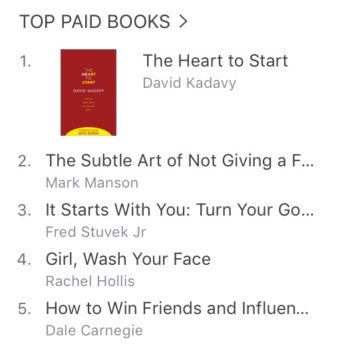
I’m still not giving up on BookBub. Even with three rejections under my belt, I will continue to apply for a featured deal in the U.S. I have many more and much better reviews in the U.S., and I expect to see more organic sales in the days following the promotion.
Other pricing promotions
During one of a couple failed paid pricing promotions (more in expanded report), I also sent the promotion to my email list of more than 20,000 subscribers, on a whim. I assumed that everyone who was interested in the book would have gotten it by now. After all, I had offered it for free only six months prior.
But I was wrong. My list went crazy for the deal. HTS shot as high as #521 overall, and was #1 in Creativity & Genius.

Additionally, I was ranked as a top business author alongside Malcolm Gladwell and Tim Ferriss.

I may have lost money on the paid portions of this promotion, but this time the promotion had staying power. Here’s how it impacted sales after the promotion, when I bumped the price back up to the seventy percent royalty rate at $2.99. You can’t even see the sales before my 99¢ promotion, but there were a few every day.

I haven’t run the numbers on that period overall, but it’s safe to say the 99¢ promotion I shared with my own list was profitable.
Pricing, in general
I have to agree with what Ryan Holiday said about pricing being a great marketing tactic. I’ve played around with price a lot during the life of The Heart to Start. It’s incredible to see the impact it has on sales.
Readers browsing through Amazon, seeing a book by an author they’ve never heard of, are incredibly price sensitive. Look at the impact on sales that came from changing the price of How to Write a Book from $1.99 to $2.99.
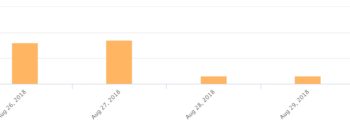
The effect on sales of one book when changing the price from $1.99 to $2.99.
Part of the way that I view this first year of The Heart to Start is that I was failing, in order to succeed. I was earning the right to charge a decent list price.
The book started out free, for awhile it was $2.99, then $3.99, then $4.99. Now it’s $9.99, and still selling. You can choose to make your money off of your loyal audience, or you can reward them for that loyalty, get social proof in return, and make up for it in sales later on. (More in the expanded version.)
Miscellaneous marketing
I have a huge list of book-marketing tactics that I would like to try. There’s no way to try them all, but I’m checking a tactic off the list every once in awhile. Here are some other tactics I’ve tried.
(Details on the performance of each of these tactics in the expanded report.)
- $119: Goodreads giveaway
- Free: Suggesting to libraries
- ~$12: Free copy of The War of Art when buying outside of Amazon
- ~$30: Giveaway with The War of Art
- ~$15: Reach out to top Amazon reviewers
- Free: Journalist/blogger outreach
- Free: Academic outreach
- Free: AMA to writing forum
- Free: Guest post
- $???: Also-bought hacking
$15,000 on advertising!?
Now for the thing that sticks out the most from my numbers. I made around $19,000 from book royalties, but I spent more than $15,000 on advertising.
When most people initially see those numbers, they think they are very bad numbers. I personally am disappointed that I spent that much to make that little.
But overall I don’t think it’s that bad. There are a number of reasons.
One, nobody likes to admit making a mistake. Okay, now let’s forget that reason.
Two, most businesses would kill for a 20% return. Consider that the average net profit margin of S&P 500 companies is around 9%. What if you spent $50,000 employing a person, and they generated $60,000 in revenue? By S&P 500 standards you would be killing it.
Running ads is a low-maintenance way to grow your business. You put money in, and you get money out. You don’t have to manage someone, and you don’t have to conduct interviews or deal with HR drama.
You do have to do a fair amount of crunching numbers in spreadsheets to do it effectively, but I personally enjoy that much more than managing someone or looking for help. Plus, I use the 3x credit card points I earn on each dollar of ad spend to travel for conferences or podcast interviews.
Third, it’s becoming more and more important for authors to know how to run ads for their books. Before I expand on that, let’s look at how that $15,000+ breaks down amongst ad platforms:
- Amazon: $13,804.36
- BookBub (including featured deal): $1,355.39
- Facebook: $143.85
- Goodreads giveaway: $119.00
- Total: $15,422.60
Why Amazon will soon be the biggest ad platform
A hot topic in the indie-author world is the fact that Amazon is clearly becoming “pay to play.” Seven-figure self-published author Mark Dawson believes that advertising your books on Amazon has recently shifted from being an obligation to being a requirement. If you want to drive sales for your books, you have to buy ads.
When you think it through, it’s hard to imagine a world where Amazon doesn’t eventually become the largest digital ad platform. Jim Kukral from the Sell More Books Show podcast, who has decades of experience in online advertising, has predicted it will happen in the next few years.
(More on why Amazon may soon be the biggest ad platform in my expanded report.)
This trend means that unless you’re an extremely successful traditionally-published author, you need to know how to run and manage Amazon ads. Traditional publishers are running Amazon ads as well, but it’s not feasible to run ads for all of their authors – they’ll only run ads for their biggest authors.
Thanks to spending the past year learning about and trying different advertising strategies, (Brian Meeks’s Mastering Amazon Ads is one good learning resource) I can now manage and optimize my ads with very little effort. I’m even experimenting with some automation (details in my November 2018 income report). You can see in this graph of ad spend and revenue that my profit margin is slowly increasing.
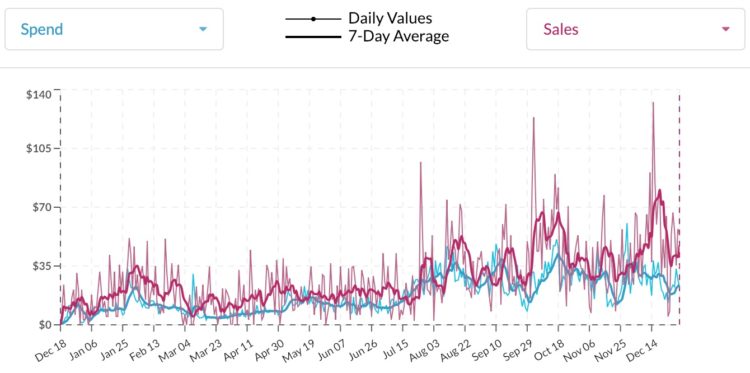
Selling books leads to organic book sales
Fourth, these book sales lead to other organic book sales. Since publishing The Heart to Start, I’ve also published two other “short reads.” Here are my total self-published book sales for 2018:
- Self-publishing income: $24,811.17
- Ad spend: $18,213.72
- Self-publishing profit: $6,597.45
- Self-publishing profit margin: 36%
While I only made a little over $3,000 from The Heart to Start in its first year, I made that once over in profit from the rest of my self-published catalog. (I spent nothing on production of my other self-published books.)
As I publish more books, I’ll start generating more organic sales. Each new book will help new readers discover past books. As Ryan Holiday says in Perennial Seller, “the best marketing you can do for your book is to start writing the next one.” You can’t expect to self publish one book and have your career set. You have to keep going.
The fifth and most compelling reason I don’t think spending all of that money on ads is so bad is this: I’ve built a foundation for The Heart to Start to drive sales for years to come.
When I decided to self publish, I knew I was making a trade-off. Instead of sitting and waiting for an email to free me from my prison of self doubt, I was going to be doing.
If I had landed a traditional publishing deal the day after my conversation with Seth Godin in April 2017 – a big “if” – my book still wouldn’t be published today, in January 2019.
I would have spent a year writing the book, and I would have spent the past nine months putting together a marketing plan for a grueling April 2019 launch that would surely make me question ever wanting to publish a book again.
Instead, I spent the past twenty-one months writing, publishing, and marketing a book – as well as two other shorter books. I know much more about what works and what doesn’t than I would otherwise, and I had fun doing it.
Most important, my book has 11,000 readers, and – according to the Amazon reviews that will drive sales far into the future – the book has had a profound impact on many of those readers. This warm reception has driven interest from publishers around the globe, who are interested in translating the book to sell it within their markets. (Foreign-rights deals take time to close, so it hasn’t happened yet, but it will.)
(More in expanded version.)
Self publishing: Is it worth it for you?
I can’t tell you whether self publishing is for you or not. I’m sure reading my story has convinced many of you it’s too little money for too much work. If an already-best-selling author only made twenty-nine cents a book – with the help of Seth Godin no less – what hope is there for a beginner?
If that’s the case, that’s a good thing. You can stop daydreaming about it and move on to something else.
I’m sure there are others amongst you who are seeing nothing but mistakes in my strategy. You think I should have done something differently, and all you can think about is how you could do better.
I made lots of mistakes, for sure, and you will, too. I only hope I can read over this a year from now and have enough new knowledge to see even more of them.
But there’s that final small group of you who are not deterred. You know you’ll make mistakes in your own journey. You know it will be one of the hardest things you ever do. But you have something inside you that won’t let you turn away. You’re compelled to move forward with a beginner’s mind, to start where you are, to learn from the biggest mistakes, and celebrate the tiniest bits of progress. If you wonder why I bothered putting together such a detailed account of my first year in self publishing – I did it for you.

